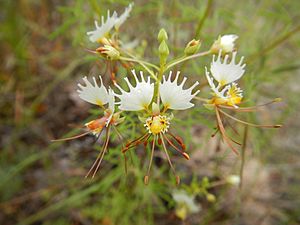Large clammyweed facts for kids
Quick facts for kids Large clammyweed |
|
|---|---|
 |
|
| Scientific classification | |
| Genus: |
Polanisia
|
| Species: |
erosa
|
| Synonyms | |
|
Cristatella erosa, Cleome erosa, Cyrbasium erosum |
|
Polanisia erosa is a fascinating plant often called large clammyweed. It's an annual herb, meaning it lives for only one growing season. This plant can grow from about 10 to 60 centimeters (4 to 24 inches) tall. It belongs to the Cleomaceae family, also known as the Cleome family.
You can spot large clammyweed by its sticky feel and its unique cream-colored flowers. These flowers have a yellow center and look a bit like tiny butterflies or even elk antlers! It also has narrow leaves that look a bit like clover. Large clammyweed loves dry, sandy places. It grows naturally in Texas and nearby states like Arkansas, Louisiana, and Oklahoma.
Contents
Plant Names and History
The first person to describe large clammyweed was an American botanist named Thomas Nuttall in 1834. He gave it the name Cristatella erosa. Later, other botanists tried different names for it. For example, Amos Eaton called it Cleome erosa in 1836.
Finally, in 1958, a botanist named Hugh Iltis decided the plant fit best in the Polanisia group. He gave it the name Polanisia erosa, which is the official name we use today. This name had "priority" because it was used earlier for similar plants. Iltis also noticed there were two slightly different types of this plant, which he called subspecies.
What Large Clammyweed Looks Like
Large clammyweed is a sticky plant that doesn't have a strong smell. It grows from 10 to 60 centimeters (4 to 24 inches) tall each year. Its stems can be green or purple. They often have tiny, sticky bumps and hairs.
Leaves and Flowers
The plant's leaves have thin stalks, which are often angled. Each leaf has three narrow leaflets. These leaflets are about 0.9 to 3.5 centimeters (0.35 to 1.4 inches) long and only 1 to 2 millimeters (0.04 to 0.08 inches) wide. They are a bit thick and often folded in half. The leaves have many tiny glands on their underside.
The flowers grow in clusters called racemes. These clusters start small, about 1 to 3 centimeters (0.4 to 1.2 inches) long. But they keep growing as the fruits ripen, reaching 6 to 8 centimeters (2.4 to 3.1 inches). Each flower has a small leaf-like part called a bract underneath it.
The flowers have four green or purple sepals, which are small leaf-like parts that protect the bud. These are about 2.5 to 3.5 millimeters (0.1 to 0.14 inches) long. The four petals are mostly creamy white. They have a yellowish, narrow base and a wider, frilly top. The lower petals are deeply cut, making them look like many tiny fingers. The upper petals are also cut, but less deeply.
Stamens and Fruit
The flowers have six to fifteen stamens, which are the parts that hold pollen. These stamens are purple and stick out beyond the petals. The plant also has a special stalk called a gynophore. This stalk holds the ovary, which is where the seeds develop.
When the fruit is ripe, the gynophore can grow to be 3 to 14 millimeters (0.12 to 0.55 inches) long. The fruit itself is a capsule, like a small pod. It is 2 to 6 centimeters (0.8 to 2.4 inches) long and about 0.25 to 0.5 centimeters (0.1 to 0.2 inches) wide. Each capsule holds 12 to 40 seeds. These seeds are dark reddish-brown and have a bumpy surface. They are about 1.5 to 1.75 millimeters (0.06 to 0.07 inches) long.
Different Types of Large Clammyweed
There are two main types, or subspecies, of Polanisia erosa:
- Polanisia erosa subsp. erosa: This type grows in eastern Texas and nearby states. Its nectar-producing parts are about 3 millimeters (0.12 inches) long. When the fruit is ripe, its gynophore is 7 to 14 millimeters (0.28 to 0.55 inches) long. Its largest petals are 7 to 11 millimeters (0.28 to 0.43 inches) long.
- Polanisia erosa subsp. breviglandulosa: This type is found in the very southern part of Texas. Its nectar-producing parts are smaller, about 1.5 millimeters (0.06 inches) long. Its gynophore is shorter, 3 to 6 millimeters (0.12 to 0.24 inches) long. Its largest petals are also a bit smaller, 6 to 9 millimeters (0.24 to 0.35 inches) long.
Where Large Clammyweed Lives
Large clammyweed grows naturally in Texas and the states right next to it, like Arkansas, Louisiana, and Oklahoma. You can find it in many different places, including open fields, grassy prairies, sandy hillsides, and even in open woodlands.

